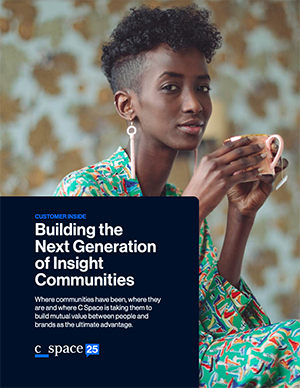This article is part of a year-long, 25th anniversary series that explores where insight communities have been, where they are today, and the market and customer trends that are shaping where C Space is taking insight communities next.

Market segmentation is one of the most foundational types of consumer research. The results of segmentation inform almost all parts of the market research portfolio, including brand building, product development, pricing and messaging. A successful segmentation framework creates organizational alignment as an ongoing source for a common understanding of a brand’s market and customer needs. A source from which all other work can be based.
Given its importance, why do so many researchers have war stories about failed segmentation efforts? A solution was too technical, not tangible enough or not actionable (to name a few common issues raised). From our over 20-year experience conducting value-based segmentations, we find that the source of these issues stems from a failure to recognize that segmentation research cannot be a purely quantitative initiative if it is to achieve its pivotal role.
Marketers face increasing challenges related to timing and budget, resulting in the temptation to self-serve with automated segmentation tools that allow them to submit attributes to clustering algorithms and create customer segments. This can lead to multiple segmentation solutions that are not aligned — and, ultimately, a fragmented understanding of customers that can create internal disorder rather than creating a common understanding that the organization can act upon in a coordinated fashion. Segmentations are not that simple.
Three steps for embedding qualitative research to increase the impact and longevity of your segmentation strategy
To guarantee a robust and actionable segmentation framework with staying power, qualitative research is a required part of the process. It plays three critical roles, two of which occur before the quantitative research phase:
1. Ensure internal alignment through in-depth interviews
Conducting in-depth interviews with key stakeholders across the business ensures the segmentation aligns with the expectations of those who will be instrumental in its adoption. Time spent here also helps focus the inputs into the segmentation, so it produces actionable results for the business. Discovering any misalignment at this stage is much better than after the quantitative research has been conducted!
2. Reflect customer perceptions and how customers think, not how the business thinks
If segmentations reflect what defines the customers—and will live on for multiple years—the survey should capture a fresh take on analyzing the market from the customers’ perspective. Conducting focus groups or an online diary can inform what language is used in the survey, what questions may create differentiation and how to allocate precious survey space.
Once the quantitative analysis begins, solutions are evaluated based on learnings from the previous qualitative phases with stakeholders and customers. A good segmentation framework is not only the product of sophisticated analytical algorithms but also a solid understanding of the customer market and the business. This is where the skills and experience of the practitioner are key to success.
Beyond identifying individual segments, a key deliverable from the quantitative phase is a typing algorithm of some form. Often, this is a select set of survey-based questions, but it can also be a projection of the segments onto the client’s customer database. This is critical to extending the shelf life of the initiative as it provides the process by which an organization can track future research and marketing efforts against the segments.
The impact of a segmentation can also be enhanced through insight communities. Using the typing tool, researchers can control the mix of members to reflect key consumer segments or use the segment framework as a lens through which to view insights and drive business results. Learn more in our guide linked below, Customer Inside: Building the Next Generation of Insight Communities.
But all this effort can fall short if we don’t stick the landing. And that’s where the third phase of qualitative research comes in.
Investing in qualitative research yields a segmentation that stands the test of time, drives organizational alignment and enhances overall marketing strategy. As business executives, supporting this investment is key to unlocking the full potential of your market research efforts.
3. Humanizing the segmentation data through ethnographic research
To ensure that the segments come to life and thrive within the business, stakeholders need to feel they truly know who they’re solving for. An ethnographic phase of research brings the segments to life and fills in gaps about the segments that could not be addressed in the quantitative phase of research without knowledge of the final segmentation framework. This step creates the final customer personas that allow the business to view the segments as more than an agglomeration of analytical facts and makes the segments come alive as real customers whom the business can embrace, interact with and remember for the long-haul.
Qualitative research is not a “nice to have,” but a necessity for effective market segmentation. Investing in these qualitative phases yields a segmentation framework that stands the test of time, drives organizational alignment and enhances overall marketing strategy. As business executives, recognizing and supporting this investment is key to unlocking the full potential of your market research efforts.
At Escalent Group (Escalent, C Space and Hall & Partners), we bake qualitative research into our segmentation process to ensure impact and long-term ROI for our clients. Contact us to discuss what a customer-centric segmentation framework could do for your brand.
And stay tuned for an upcoming blog post on a step-by-step guide for effectively activating and socializing segmentations throughout your organization.







